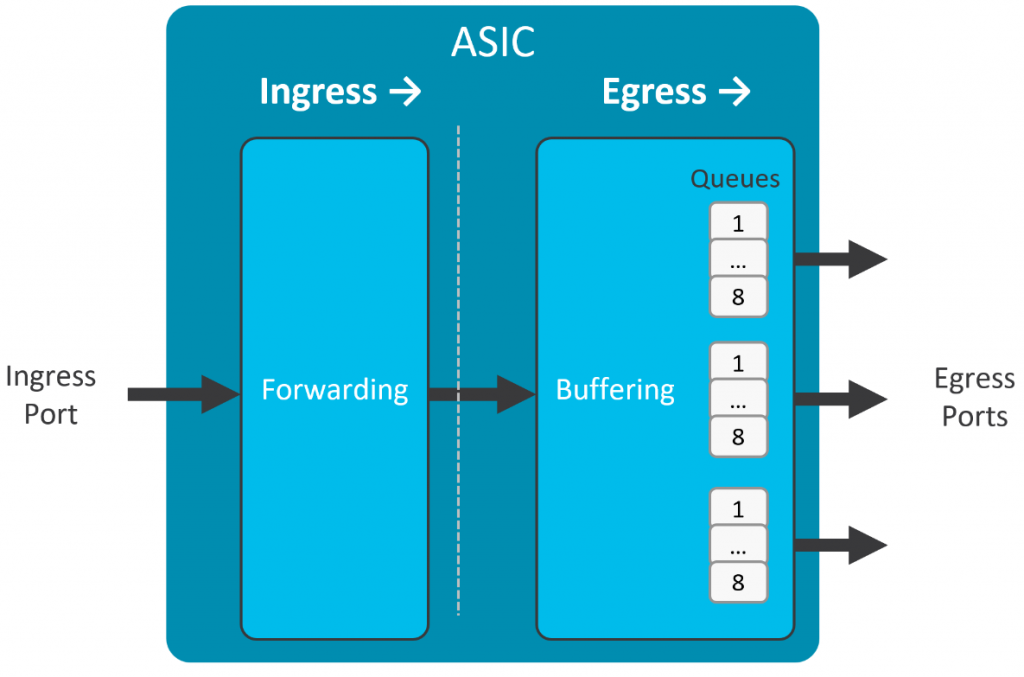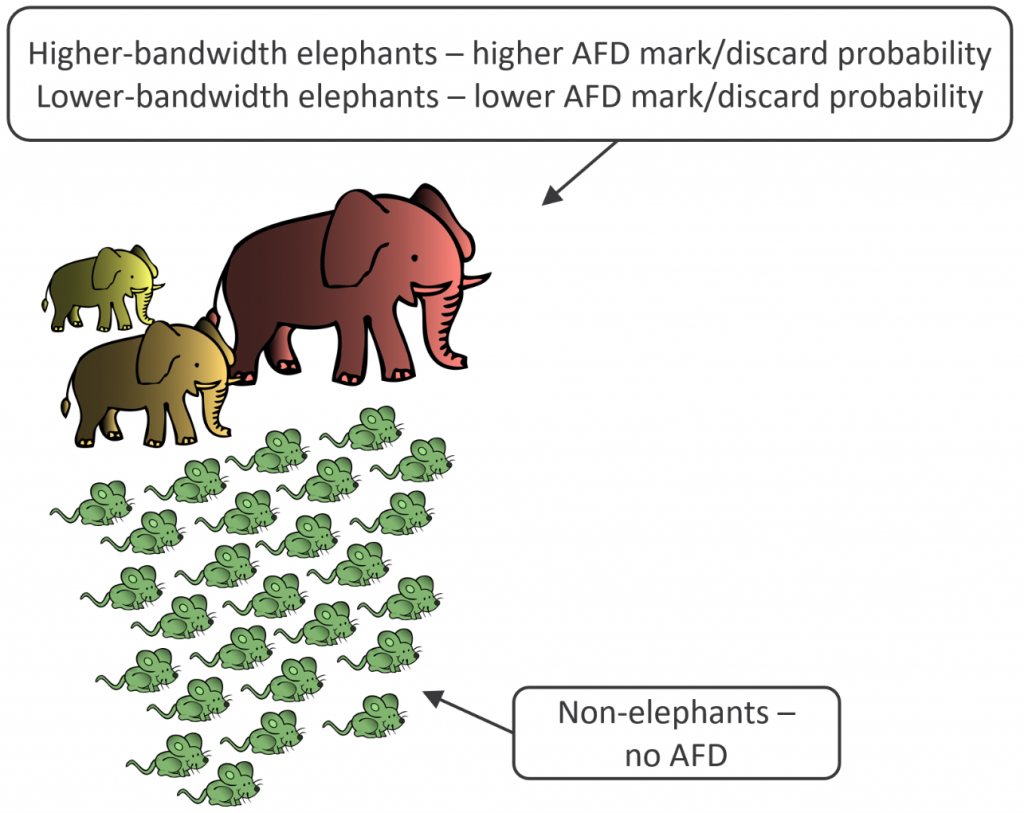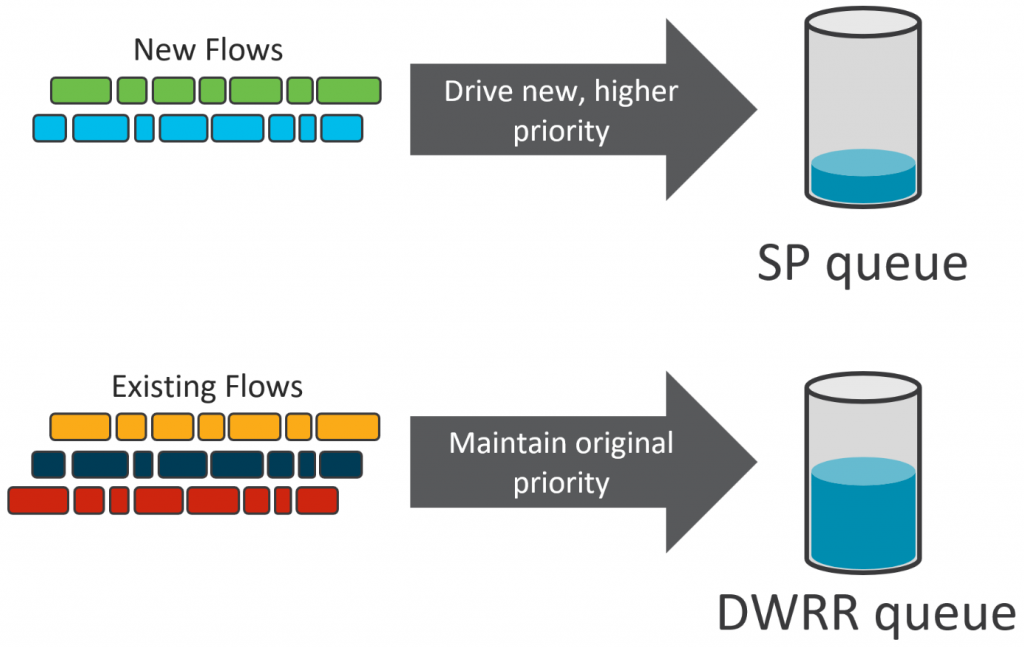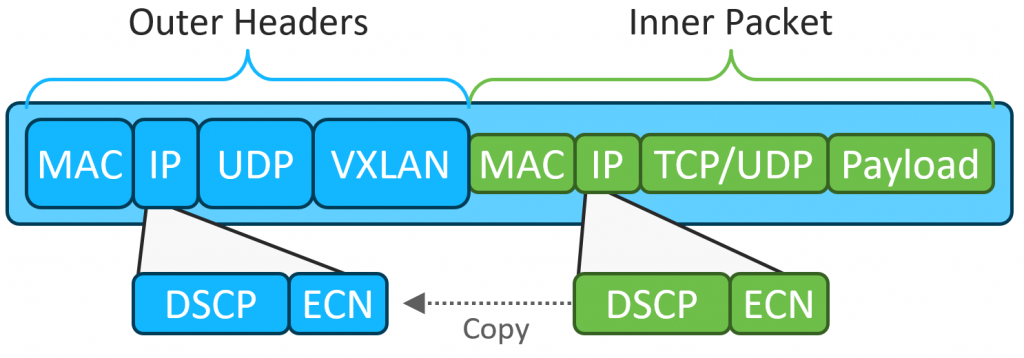
[ad_1]
As shoppers migrate to community materials in response to Digital Extensible Native Space Community/Ethernet Digital Personal Community (VXLAN/EVPN) era, questions concerning the implications for utility efficiency, High quality of Provider (QoS) mechanisms, and congestion avoidance continuously stand up. This weblog put up addresses one of the commonplace spaces of bewilderment and worry, and touches on a couple of very best practices for maximizing the price of the usage of Cisco Nexus 9000 switches for Knowledge Heart material deployments by means of leveraging the to be had Clever Buffering features.
What Is the Clever Buffering Capacity in Nexus 9000?
Cisco Nexus 9000 sequence switches put into effect an egress-buffered shared-memory structure, as proven in Determine 1. Each and every bodily interface has 8 user-configurable output queues that contend for shared buffer capability when congestion happens. A buffer admission set of rules known as Dynamic Buffer Coverage (DBP), enabled by means of default, guarantees honest get right of entry to to the to be had buffer amongst any congested queues.

Along with DBP, two key options – Approximate Truthful Drop (AFD) and Dynamic Packet Prioritization (DPP) – assist to hurry preliminary circulation institution, scale back flow-completion time, keep away from congestion buildup, and handle buffer headroom for soaking up microbursts.
AFD makes use of inbuilt {hardware} features to split particular person 5-tuple flows into two classes – elephant flows and mouse flows:
- Elephant flows are longer-lived, sustained bandwidth flows that may get pleasure from congestion management indicators akin to Particular Congestion Notification (ECN) Congestion Skilled (CE) marking, or random discards, that affect the windowing conduct of Transmission Keep watch over Protocol (TCP) stacks. The TCP windowing mechanism controls the transmission price of TCP periods, backing off the transmission price when ECN CE markings, or un-acknowledged collection numbers, are seen (see the “Extra Data” phase for extra main points).
- Mouse flows are shorter-lived flows which might be not going to get pleasure from TCP congestion management mechanisms. Those flows include the preliminary TCP 3-way handshake that establishes the consultation, along side a fairly small collection of further packets, and are therefore terminated. By the point any congestion management is signaled for the circulation, the circulation is already entire.
As proven in Determine 2, with AFD, elephant flows are additional characterised in keeping with their relative bandwidth usage – a high-bandwidth elephant circulation has a better chance of experiencing ECN CE marking, or discards, than a lower-bandwidth elephant circulation. A mouse circulation has a 0 chance of being marked or discarded by means of AFD.

For readers accustomed to the older Weighted Random Early Hit upon (WRED) mechanism, you’ll be able to bring to mind AFD as a type of “bandwidth-aware WRED.” With WRED, any packet (without reference to whether or not it’s a part of a mouse circulation or an elephant circulation) is doubtlessly topic to marking or discards. Against this, with AFD, handiest packets belonging to sustained-bandwidth elephant flows is also marked or discarded – with higher-bandwidth elephants much more likely to be impacted than lower-bandwidth elephants – whilst a mouse circulation is rarely impacted by means of those mechanisms.
Moreover, AFD marking or discard chance for elephants will increase because the queue turns into extra congested. This conduct guarantees that TCP stacks back down neatly earlier than all of the to be had buffer is fed on, fending off additional congestion and making sure that ample buffer headroom nonetheless stays to take in instant bursts of back-to-back packets on in the past uncongested queues.
DPP, some other hardware-based capacity, promotes the preliminary packets in a newly seen circulation to a better precedence queue than it could have traversed “naturally.” Take for instance a brand new TCP consultation institution, consisting of the TCP 3-way handshake. If any of those packets take a seat in a congested queue, and due to this fact revel in further lengthen, it could possibly materially have an effect on utility efficiency.
As proven in Determine 3, as a substitute of enqueuing the ones packets of their at the start assigned queue, the place congestion is doubtlessly much more likely, DPP will advertise the ones preliminary packets to a higher-priority queue – a strict precedence (SP) queue, or just a higher-weighted Deficit Weighted Spherical-Robin (DWRR) queue – which leads to expedited packet supply with an excessively low likelihood of congestion.

If the circulation continues past a configurable collection of packets, packets are now not promoted – next packets within the circulation traverse the at the start assigned queue. In the meantime, different newly seen flows could be promoted and revel in the good thing about sooner consultation institution and circulation finishing touch for short-lived flows.
AFD and UDP Site visitors
One continuously requested query about AFD is that if it’s suitable to make use of it with Consumer Datagram Protocol (UDP) site visitors. AFD on its own does now not distinguish between other protocol varieties, it handiest determines if a given 5-tuple circulation is an elephant or now not. We most often state that AFD will have to now not be enabled on queues that elevate non-TCP site visitors. That’s an oversimplification, after all – for instance, a low-bandwidth UDP utility would by no means be topic to AFD marking or discards as a result of it could by no means be flagged as an elephant circulation within the first position.
Recall that AFD can both mark site visitors with ECN, or it could possibly discard site visitors. With ECN marking, collateral harm to a UDP-enabled utility is not going. If ECN CE is marked, both the applying is ECN-aware and would alter its transmission price, or it could forget about the marking utterly. That stated, AFD with ECN marking gained’t assist a lot with congestion avoidance if the UDP-based utility isn’t ECN-aware.
Then again, when you configure AFD in discard mode, sustained-bandwidth UDP programs might endure efficiency problems. UDP doesn’t have any built in congestion-management mechanisms – discarded packets would merely by no means be delivered and would now not be retransmitted, no less than now not in response to any UDP mechanism. As a result of AFD is configurable on a per-queue foundation, it’s higher on this case to easily classify site visitors by means of protocol, and be sure that site visitors from high-bandwidth UDP-based programs all the time makes use of a non-AFD-enabled queue.
What Is a VXLAN/EVPN Material?
VXLAN/EVPN is without doubt one of the quickest rising Knowledge Heart material applied sciences in fresh reminiscence. VXLAN/EVPN is composed of 2 key components: the data-plane encapsulation, VXLAN; and the control-plane protocol, EVPN.
You’ll to find ample main points and discussions of those applied sciences on cisco.com, in addition to from many different assets. Whilst an in-depth dialogue is out of doors the scope of this weblog put up, when speaking about QOS and congestion leadership within the context of a VXLAN/EVPN material, the data-plane encapsulation is the focal point. Determine 4 illustratates the VXLAN data-plane encapsulation, with emphasis at the interior and outer DSCP/ECN fields.

As you’ll be able to see, VXLAN encapsulates overlay packets in IP/UDP/VXLAN “outer” headers. Each the interior and outer headers comprise the DSCP and ECN fields.
With VXLAN, a Cisco Nexus 9000 transfer serving as an ingress VXLAN tunnel endpoint (VTEP) takes a packet originated by means of an overlay workload, encapsulates it in VXLAN, and forwards it into the material. Within the procedure, the transfer copies the interior packet’s DSCP and ECN values to the outer headers when acting encapsulation.
Transit gadgets akin to material spines ahead the packet in response to the outer headers to achieve the egress VTEP, which decapsulates the packet and transmits it unencapsulated to the overall vacation spot. Via default, each the DSCP and ECN fields are copied from the outer IP header into the interior (now decapsulated) IP header.
Within the technique of traversing the material, overlay site visitors might go thru a couple of switches, every imposing QOS and queuing insurance policies outlined by means of the community administrator. Those insurance policies would possibly merely be default configurations, or they will include extra advanced insurance policies akin to classifying other programs or site visitors varieties, assigning them to distinctive categories, and controlling the scheduling and congestion leadership conduct for every magnificence.
How Do the Clever Buffer Functions Paintings in a VXLAN Material?
For the reason that the VXLAN data-plane is an encapsulation, packets traversing material switches include the unique TCP, UDP, or different protocol packet inside of a IP/UDP/VXLAN wrapper. Which ends up in the query: how do the Clever Buffer mechanisms behave with such site visitors?
As mentioned previous, sustained-bandwidth UDP programs may doubtlessly be afflicted by efficiency problems if traversing an AFD-enabled queue. On the other hand, we will have to make an excessively key difference right here – VXLAN is now not a “local” UDP utility, however quite a UDP-based tunnel encapsulation. Whilst there’s no congestion consciousness on the tunnel stage, the unique tunneled packets can elevate any roughly utility site visitors –TCP, UDP, or just about some other protocol.
Thus, for a TCP-based overlay utility, if AFD both marks or discards a VXLAN-encapsulated packet, the unique TCP stack nonetheless receives ECN marked packets or misses a TCP collection quantity, and those mechanisms will reason TCP to scale back the transmission price. In different phrases, the unique function continues to be completed – congestion is have shyed away from by means of inflicting the programs to scale back their price.
In a similar fashion, high-bandwidth UDP-based overlay programs would reply simply as they’d to AFD marking or discards in a non-VXLAN surroundings. When you’ve got high-bandwidth UDP-based programs, we advise classifying in response to protocol and making sure the ones programs get assigned to non-AFD-enabled queues.
As for DPP, whilst TCP-based overlay programs will receive advantages maximum, particularly for preliminary flow-setup, UDP-based overlay programs can receive advantages as neatly. With DPP, each TCP and UDP short-lived flows are promoted to a better precedence queue, rushing flow-completion time. Subsequently, enabling DPP on any queue, even the ones sporting UDP site visitors, will have to supply a favorable affect.
Key Takeaways
VXLAN/EVPN material designs have won vital traction in recent times, and making sure superb utility efficiency is paramount. Cisco Nexus 9000 Sequence switches, with their hardware-based Clever Buffering features, be sure that even in an overlay utility surroundings, you’ll be able to maximize the environment friendly usage of to be had buffer, reduce community congestion, velocity flow-establishment and flow-completion occasions, and keep away from drops because of microbursts.
Extra Data
You’ll to find extra details about the applied sciences mentioned on this weblog at www.cisco.com:
Percentage:
[ad_2]